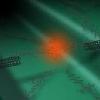A network of space buffs is learning to track asteroids more accurately than ever to predict exactly when and where the next killer meteorite will strike
A rush of percussive blasts followed the display, prompting some people in the region to run inside and hide, while others watched in awe. Mohammed Elhassan, walking home from his local mosque in the Nile city of Wadi Halfa, took out his mobile phone and snapped a few photos. Head-on, from his position, the dust looked almost like some scribbling from a child. Some locals even told interviewers they divined a message in the pattern: a sign from Mohammed approving of their Ramadan fast.
Astronomers would later confirm a heavenly portent of another kind?the last dance of an asteroid the size of a sedan that ripped through the atmosphere at 45,000 kilometres an hour and erupted into a fireball some 37km above the desert floor. Scientists had spotted the rock, dubbed 2008 TC3, en route to the planet 20 hours earlier during routine telescope observations of the night sky. Earth-bound objects of this size appear only a few times a year, typically smashing into the atmosphere unnoticed and exploding into harmless, untraceable bits of dust. TC3 was different. It wasn?t that it was any more dangerous; it was too fragile to get through the atmosphere intact. But because astronomers found it early, while it was still 483,000km from Earth, out beyond the moon, it presented them with a rare opportunity to trace its path and predict exactly where and when it would crash to Earth. The feat would be a historic first. Moreover, samples, if they could be retrieved, might reveal new insights about the mysterious interior of asteroids?essential knowledge if you?re trying to devise a way to keep them from obliterating a city.
Back in Sudan, the pebble-like meteorites formed by the explosion in the atmosphere had scattered miles over the desert, lost on the rocky plain. It was up to astronomer Peter Jenniskens to find them.
Spotting Trouble
NASA?s Near-Earth Object (NEO) Program, headquarted at the Jet Propulsion Laboratory in Pasadena, California, has been identifying and tracking asteroids within striking distance of Earth since 1998. Of the 6,326 rocks the NEO Program has so far catalogued, at least 783 measure more than a kilometre wide. That?s big enough to potentially end civilisation. At present, the risk of a large asteroid slamming into Earth is slim?the rock with the best shot has a 1 in 2,900 chance of striking in 2048?but astronomers are keeping their telescopes tuned because these orbits could shift over time, increasing the chance of impact. There are an estimated half a million asteroids in the 45 metre range, which strike Earth roughly once every 300 years. These rocks may not wipe out humanity, but they can cause serious damage if they hit the ground or explode in the atmosphere. Scientists believe one may have burst above Siberia in 1908, unleashing a shock wave so powerful it flattened 2,000 square kilometres of forest. Imagine if it exploded above Sydney…
To get the full story, pick up the latest issue of Popular Science Magazine, on sale now!
JOIN THE POPSCI AU FACEBOOK GROUP
Popular Science Australia - reporting on the intersection of science, technology and everyday life. Whether you want to learn about high tech gadgets, find science projects, read the latest space news or search for the best computers or best digital cameras…you‚Äôll find it at PopSci.com.au
Popular Science has been a leading source of science, technology and gadget news since 1872. With up-to-the minute latest space news, insightful commentary on the new innovations and concept cars ...if it's new or future technology you'll find it at popsci.com.au.
WW Media - Popular Science © 2010
Cameras - Home Entertainment - Mobile Phones




